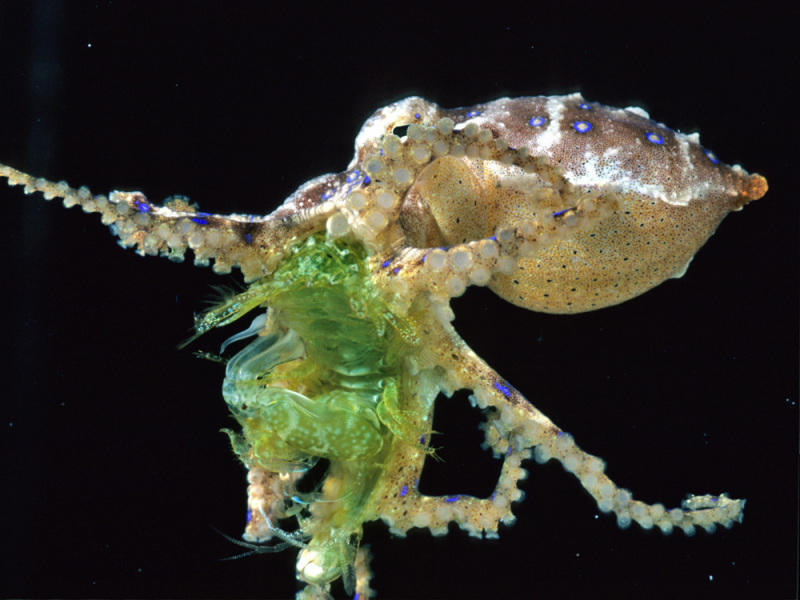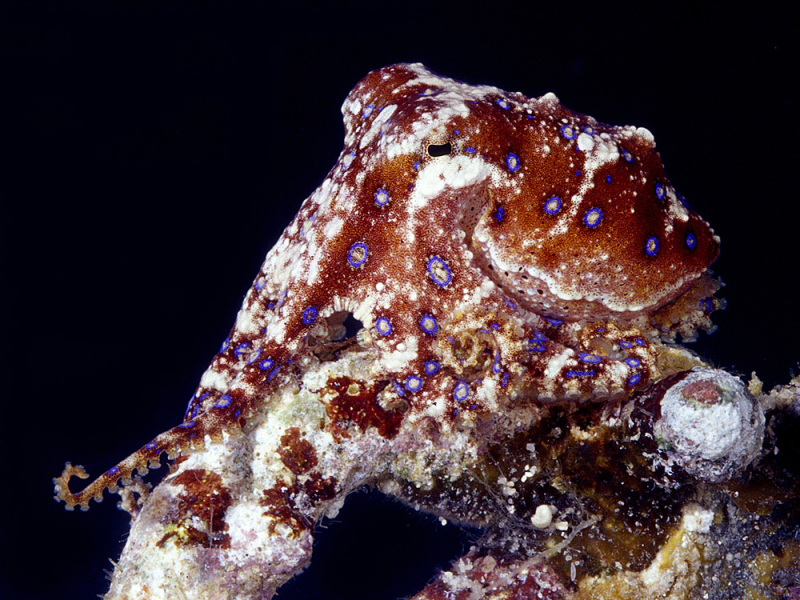�
�

©Roy Caldwell: Hapalochlaena sp. with crustacean prey, from Lizard Island. This photo appears in Reid (2016) incorrectly labelled as Hapalochlaena maculosa.
�
���
Hapalochlaena sp.
Blue-ringed Octopus

©Roy Caldwell: Hapalochlaena sp. with crustacean prey, from Lizard Island. This photo appears in Reid (2016) incorrectly labelled as Hapalochlaena maculosa.
Kingdom
Animalia
Phylum
Mollusca
Class
Cephalopoda
Order
Octopoda
Family
Octopodidae
Genus
Hapalochlaena
Species
Hapalochlaena sp.
Colours
Distinguishing features
This is the only octopus known from the Lizard Island area that has small bright blue rings on the body and arms. It is small (arms to 7 cm long) and has a functional ink sac (Norman, 2000). Females lay large eggs that hatch demersal juveniles without going through a planktonic stage (Roy Caldwell, pers. comm., 2015).
Size
- Size data has not been obtained.
Synonyms
Similar taxa
-
Animalia:
species: Hapalochlaena fasciata
is a valid species found in southeastern Australia. Its record from Lizard Island by Roper and Hochberg (1988) is likely to be incorrect. -
Animalia:
species: Hapalochlaena maculosa
is a valid species found in southern Australia. Records of it from Lizard Island are based on misidentifications by Roper and Hochberg (1986, 1988) according to Roy Caldwell (pers. comm.)
Comments
At Lizard Island, Roy Caldwell has found this species in rubble and bivalve shells at Cobia Hole, on algae in Watson's Bay and around the base of patch reefs.
by Anne Hoggett
This is the species referred to by Norman (2000) as Hapalochlaena sp 5.
by Anne Hoggett
Web resources
Danger
- unspecified - All members of this genus have strong salivary toxins. Some species, including the Southern Blue-lined Octopus (Hapalochlaena fasciata, found in southeast Australia) have caused human fatalities (Norman, 2000). The Lizard Island species should also be regarded as dangerous.
References
References that assist with identification
- Norman, M. (2000). Cephalopods: A world guide ConchBooks, Hackenheim, Germany.
- Reid, A. (2016). Cephalopods of Australia and Sub-Antarctic Territories CSIRO, Clayton, Vic., Australia.
Other references
- Huffard, C.L., N. Saarman, H. Hamilton and W.B. Simpson (2010). The evolution of conspicuous facultative mimicry in octopuses: an example of secondary adaptation? Biological Journal of the Linnean Society, 101: 68-77. LIRS catalog number 1359.
- View all references
